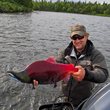Dam removal in America receives a great amount of attention these days, thanks in no small part to a growing group of activists, filmmakers and other advocates that have been fighting to free rivers all across the country from the negative impacts of dams. Concerns about the impact of hydroelectric dams and other similar projects aren't only being raised here in the United States, however. In Europe, many of the same battles are being waged, with varying levels of success. The One that Got Away, a documentary film out of Austria, details the efforts led by a group of anglers, scientists and others that share a passion for the Mur River and its Huchen (or Danube Salmon), a threatened member of the salmon family that grows to impressive size.
Similar in appearance to the Mongolian Taimen, the Huchen is endangered throughout its limited range. The Huchen has been in sharp decline for the past 100 years, due mostly to habitat destruction and fragmentation. According to the IUCN list of threatened and endangered species, "The main current threat to the species is the flow regulation from hydropower dams which impact the species, and their prey's, habitat and pollution. Documented self-sustaining populations are very few."




























